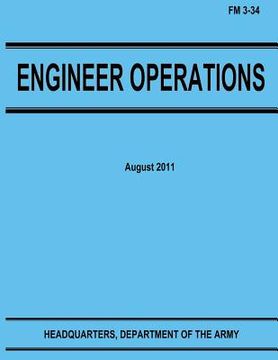Synopsis "Engineer Operations (FM 3-34)"
Field Manual (FM) 3-34, "Engineer Operations," is the Army's keystone doctrinal publication for the Engineer Regiment. It presents overarching doctrinal guidance and direction for conducting engineer activities and shows how they contribute to full spectrum operations. It provides a common framework and language for engineer support to operations and constitutes the doctrinal foundation for developing the other fundamentals and tactics, techniques, and procedures (TTP) detailed in subordinate doctrinal manuals in the FM 3-34 series. This manual is a key integrating publication that links the doctrine for the Engineer Regiment with Army capstone doctrine and joint doctrine. It focuses on synchronizing and coordinating the diverse range of capabilities in the Engineer Regiment to successfully support the Army and its mission. FM 3-34 provides operational guidance for engineer commanders and trainers at all echelons and forms the foundation for Army Engineer School curricula. This edition of FM 3-34 provides keystone doctrine on engineer support to operations with a chapter for each of the three major sections of the engineer framework and chapters on mission command considerations, engineers in the operations process, and sustainment considerations. Chapter 1 draws from the right side of the engineer framework in figure 1, page vii, examining the context within which engineer support to operations occurs, focusing on those aspects that are most significant to engineers. It provides an engineer view of the following: the operational environment (OE), the operational and mission variables used to describe the OE, unified action, the continuum of operations, the levels of war, and the Army's operational concept-full spectrum operations. The chapter highlights the requirement to simultaneously support offensive, defensive, and stability or civil support operations. Chapter 2 addresses the left side of the engineer framework, providing an overview of the Engineer Regiment, its organizational modularity, and its capabilities. It defines and discusses the engineer disciplines (combat, general, and geospatial engineering), highlighting their interdependence. Chapter 3 addresses the middle portion of the engineer framework, defining the four lines of engineer support and describing their relationships to the engineer disciplines, full spectrum operations, and the warfighting functions. It describes engineer contributions to combat power linked through the lines of engineer support, the capabilities inherent in the engineer disciplines, and the warfighting functions. Chapter 4 provides mission command considerations for engineer support, to include the use of various functional and multifunctional headquarters, describing how the Engineer Regiment "organizes for combat," and synchronizes engineer support to operations with those of other forces. It discusses engineer force tailoring, task organizing, and mission command of engineer forces. Chapter 5 describes how engineer support is integrated into the supported commander's overall operation throughout the operations process. It describes engineer planning activities and considerations for preparing, executing, and continuously assessing engineer support. Chapter 6 discusses sustainment of engineer capabilities. Successful engineer support to operations includes effective incorporation of sustainment support. This chapter describes the integrated sustainment effort required for engineer support to operations. Appendix A expands on the discussion of the engineer view of unified action in chapter 1. It describes engineer considerations for multinational and interagency operations and for working with nongovernmental organizations (NGO) and in host nations (HNs). Appendix B supplements the information about operational force engineers in chapter 2.

